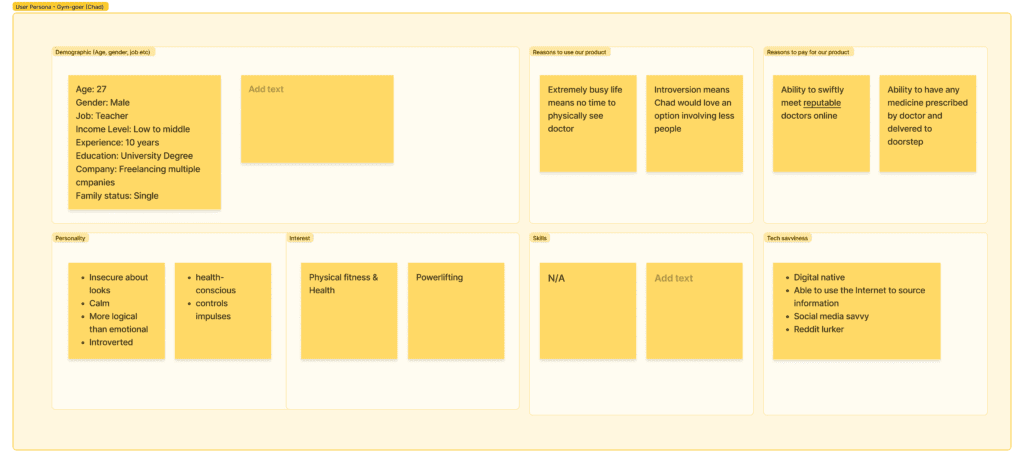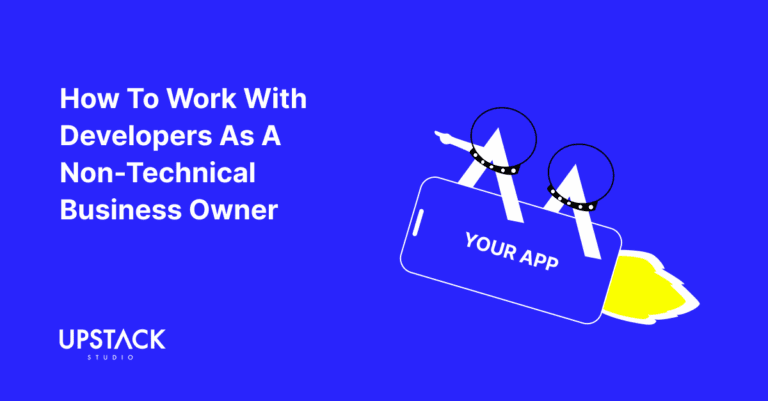A Product Roadmap Makes Work Easy
In app development, inspiration can be random, but success is always planned.
A great idea can suddenly appear in your head, it happens all the time.

Turning it into a real, working app?
Now that takes some EFFORT, which doesn’t happen all the time.
That’s why many great ideas forever stay ideas.
Successful products start with a good product roadmap, apps included.
By the end of this article, you will know:
- What a product roadmap is and why everyone needs one
- What a product roadmapping workshop with Upstack Studio is like, and
- What a product roadmap is not
Product Roadmaps and the ‘Big C’
Over the past five years, whenever our team conducts a product roadmapping workshop with a non-tech founder, the same thing happens.
At some point in the workshop, the client will say:
“Oh shit, I didn’t think of that.”
That “oh shit” would go on to save them tens of thousands of dollars.
Every time.
It never gets old for us. That’s what a workshop is for – to provide everyone from the founder to the developers with the ‘Big C’.

Clarity gets shit done.

With clarity, everything else falls into place.
And that’s really what we’d like you to take away from this blog post.
The question isn’t “Do I need a product roadmap?”.
Yes, you do.
The question is:
“How can I walk away from a product roadmapping workshop and have total clarity on what needs to be done?”
Here’s how.
First, we address a fundamental question:
What’s a Product Roadmap?
Close your eyes and think of your future app.
We’re serious! Close your eyes now and try to envision it with as much detail as possible.
Can you clearly see it and what it looks like?
Chances are you can’t. You can only catch glimpses of what you want it to be.
Why? Because there’s no clarity.
What’s happening is you’re feeling it. You’re imagining the solution working and how that feels.
You, dear reader, are living in the future. A product roadmap lets you and your developer identify and align on the concrete steps we need to get there.
It’s going to take a lot of steps, and the product roadmap tells us the first ten, then the next ten, and then the next.
And then we have your app, just as planned.
What Happens Without a Product Roadmap?
For starters, you’ll be working with a developer and neither of you can read the other’s mind.
If there is no documentation to align everyone, it can get chaotic fast, especially when you consider the second point: there will be changes.
They may not be huge changes, but there will be changes because people don’t know what they want until they actually have a chance to use it. If we ever need to retrace our steps and go in a different direction, a roadmap makes that so much easier.
Product Roadmapping Workshop at Upstack Studio
If you’re sold, why are we still selling?
Sign up for our product roadmapping workshop and see you there!
If you’re still on the fence, let’s do some roleplay.
We’re going to play ourselves: a team of Upstackers.
You’ll also play yourself: a non tech founder attending our product roadmapping workshop.
Before founders attend, we send them our app brief template to fill in, so we have some existing knowledge of the idea beforehand.
You can grab a copy through the form below.
Download this FREE editable template now to craft your perfect App Brief! Let us know where should we send it through the form below.
If there’s nothing else, then…

Let’s GO!
Welcome to Upstack Studio’s Product Roadmapping Workshop!
Here’s our agenda for the day:
- Product Overview & Team Introduction (5 minutes)
- Target Audience (45 minutes)
- Problem Statements (15 minutes)
- Value Proposition (30 minutes)
- Type of App (5 minutes)
- QUICK BREAK (PHEW)
- Brain Dump 1 (60 minutes)
- Lunch Break
- Brain Dump 2 (60 minutes)
- Prioritization (60 minutes)
- Collapse in exhaustion (the rest of the day)
In total, we will be spending about four – six hours together, so we hope you are fresh and ready to go.

We also ask that you turn off your other devices and give this workshop your full attention. In turn, we will do the same for you.
Finally, we will be observing time – ten minutes to a section means ten minutes and no more!
That’s pretty much what happens during our Product Overview & Team Introduction stage, which means we can move on to the first real part:
Target Audience (45 minutes)
Goal: Identify specific user persona(s).
Who is the persona you’re trying to reach here?
We will now have a no-holes-barred discussion about who you want to help.
- What are their circumstances?
- What are their personality traits?
- What would compel them to use a particular solution?
Here’s an example of one we’ve filled out.
We’ve given the user a name (Chad) and mapped out relevant parts of his life.

Click on it to open it in a new tab for a closer look.
During the session, we try to identify as many personas as possible, but for now, we’d like you to try coming up with just one. Use what we’ve filled in as an example.
Done? Nice.
Next step:
Problem Statement (15 minutes)
Goal: describe the problem(s) faced by our persona(s) we want to solve.
For the next 15 minutes, we list down as many problems as we can think of, then vote on the three most urgent.
For practice, we’d like you to write down just one.
We’ll start; here’s a problem faced by Chad:
Your turn.
Next stage:
Value Proposition (30 minutes)
Goal: Clearly state what value we provide to solve that pain point.
It could be a standalone service or a bundle of services, preferably highlighting what competitors lack.
Again, we try to list down as many as we can (which explains all the boxes).
Once done, we group the propositions into distinct categories and vote on the three most compelling options.
We’d like you to write down just one value proposition for your persona.
Here’s what we’ll offer Chad.
Your turn.
Ok, now on to…
Type of App (5 minutes)
Goal: Based on everything we know so far, should we go with a mobile app or mobile site?
By the way, 80% of the time, we find a site is good enough.
What ensues is us having to convince the founder they don’t need an app.
But man, you guys can be stubborn!
Be careful not to fall in love with the idea of an app.
An app isn’t an idea, it’s just an interface. And a really expensive one.
We’re trying to save you time and money here, so help us help you!
This is really something you’d let your developer advise you on based on your specific use case.
If you’re interested, check out how we decided between mobile app or mobile site for some of our past clients.
For now, onto the next part:
The Brain Dump (60 minutes)
We promised no more toilet jokes, that’s really what this section is called.
Goal: think up as many features as possible.
Don’t stop to think about things like practicality or cost-effectiveness.
If you think your app’s gonna need it, list it down.
For Chad, these are features we immediately think the app will need:
Your turn. Think of three features your solution will need.
By the way: Our current record for the most features in one brain dump is 211!
Obviously, that is total overkill, and we ended up cutting it down to 103 in the next section, where we…
Prioritize (60 minutes)
Here the product roadmap starts to take shape.
We screen every feature with these five questions:
- Can we hold this feature off for a week or more?
- If we remove this, does the product still solve the main customer problem?
- If we remove this, does the product still function?
- Did I add this because it’s sexy and shiny?
- Is the founder on the fence about this feature?
The goal: determine the least amount of features your app needs to qualify as a Minimum Lovable Product.
Same concept as Minimum Viable Product, but an MVP just asks whether the app does what it’s supposed to.
If you’re thinking of a lovable product, it’s more like, what’s the least your app has to do for customers to genuinely enjoy the experience of using it?
Humans are emotional creatures; we make choices based on how we feel.
Why settle for viable? We need to make your app lovable.
We also sort through these features to see what can initially be done manually.
Why?
To save costs.
For example, users may want to make purchases through your app or site from day one.
Instead of starting out with an integrated payment gateway, we might recommend founders leave a bank account and phone number and ask that those interested send screenshots of transfers.
It’s not sexy, but at this point, ‘sexy’ has very little return on investment.
Let’s see what Mr. Wonderful from Shark Tank has to say.

“Stop trying to be sexy and listen to Upstack Studio or I’m out!”
That settles it, then.
Once numbers start to pick up, we can talk about automation.
And let’s just say numbers never pick up (the app game can be brutal).
At least you’ve proactively mitigated some of your losses.
The End of the Product Roadmapping Workshop – What Now?
By now, we have a tentative product roadmap.
You can check out our sample report by downloading it through the form below.
Want to get a sneak peek at the Product Roadmap we send to our clients? Let us know where should we send it through the form below.
A few things we’d like to point out:
- it’s concise
- it’s detailed enough to cover the next 4-6 months
- it’s got no hard dates, only ranges
A roadmap isn’t meant to be a novel, and should only contain necessary information. Software development is also never 100% predictable, and just like in a moshpit, some wiggle room must be provided.
With this, we have crystal clear clarity.
We’re sure of what needs to be done, and now we can execute.

Time to kill some bugs.
And just like that, congrats on making it to the end of the Upstack Studio Product Roadmapping Workshop!
Does it end here?
Nope.
Our team will follow up with a confirmation email of everything we recorded, you have a final chance to say, “Guys, I was drunk that day, can we do it all over again?’
Or, hopefully, you’ll say “Hell yeah, let’s do this.”
Then the real journey begins, but that’s a story for another day.







